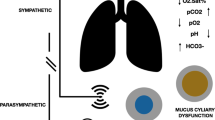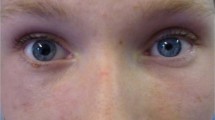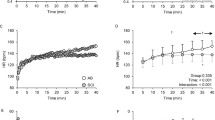Abstract
Study design:
Case reports.
Objectives:
To describe Cheyne–Stokes respiration (CSR) and associated circulatory abnormalities in three patients with spinal cord lesions.
Setting:
Veterans Administration Hospital, USA.
Subjects:
One paraplegic patient with coronary artery disease in congestive heart failure, one tetraplegic patient with alcoholic cardiomyopathy and postural hypotension, and one tetraplegic complete patient with cardiomegaly, severe aortic atherosclerosis, and postural hypotension.
Methods:
Breathing activity was measured with a nasal thermistor or abdominal stretch transducer. Cardiac activity was estimated with a photoelectric sensor for cutaneous blood flow placed on the forehead or a piezoelectric transducer for pressure positioned over an artery or the cardiac apex. Tracings were drawn on a strip chart recorder. The subjects were at rest in semireclining positions.
Results:
Survey times were 17–21 min, and cycling periods were 41–72 s. Periodic changes in the depth of breathing were accompanied by periodic changes in amplitude of forehead cutaneous pulse, blood pressure, or apical cardiac impulse in all patients. Peak circulation occurred at or following peak respiration. In addition, cyclical pulsus alternans occurred in two patients.
Conclusion:
Three spinal cord injury patients sustained CSR and circulatory periodicity associated with cardiac disease and postural hypotension.
Similar content being viewed by others
Introduction
Cheyne–Stokes respiration (CSR) – crescendo–decrescendo breathing cycling with apnea – is usually associated with congestive heart failure or cerebrovascular disease.1, 2, 3, 4, 5, 6 CSR has not been reported in patients with spinal cord lesions, but the same predisposing factors can exist. CSR can serve as a sign of underlying circulatory abnormality. To alert practitioners that CSR can develop in patients with spinal cord lesions and to describe factors that might apply to CSR in these patients, three cases from the spinal cord injury (SCI) service are discussed.
Methods
The subjects are described in Table 1.
Monitoring techniques were as follows. Periodicity of breathing was assessed by nasal air flow, measured with a thermistor (Astro-Med, Warwick, RI, USA) clipped to one naris, or by diaphragm activity, measured with a Pneumobelt, an elastic transducer stretched around the abdomen at the level of the umbilicus (UFI, Morro Bay, CA, USA). Cutaneous circulation was monitored with an infrared transducer (Astro-Med, Warwick, RI, USA) held against the forehead with an elastic band. Alternately, circulation was monitored with a piezoelectric pulse pressure transducer (UFI, Morro Bay, CA, USA) held against a finger tip or the precordium with an elastic band, measuring blood pressure or tracing a cardiac impulse, respectively. Beat to beat pulses were traced on a polygraph with a strip chart recorder (Model 79E, Grass Instruments Co., Quincy, MA, USA). Cycles of breathing and pulse were measured by eye.
Results
Patient 1 was monitored for 21 min at 30 degrees of head elevation. A total of 17 cycles of periodic breathing were observed, the duration of a cycle averaging 72 s. Enhanced breathing, precordial activity, and cutaneous blood flow were in phase and directly related in amplitude, Figure 1. Pulse amplitude changes were sometimes abrupt. Pulsus alternans occasionally developed as pulse amplitude increased. Pulse rate varied little, 75–78 beats/s. The patient expired a year after the survey with pulmonary edema.
Patient 1. Cutaneous blood flow of the forehead (bottom) versus apical cardiac pulse (middle) versus diaphragmatic activity (top panel). Changes in blood flow and apical cardiac pulse occurred abruptly and correlated with changes in diaphragmatic activity. Pulsus alternans occurred during the enhanced blood flow phase. The duration of the tracing shown is 140 s
Patient 2 was monitored for a total of 16 min in the supine position during which time 15 cycles of hyperventilation and apnea occurred, the average duration being 68 s. An equal number of cutaneous blood flow cycles occurred. Pulse amplitude increased after the peak of hyperpnea phases, Figure 2. As pulse amplitude increased, pulsus alternans sometimes appeared. As pulse amplitudes decreased, pulse rates increased – 60–96 beats/min. The patient expired 5 years later of cardiac arrest.
Patient 2. Cutaneous blood flow of the forehead (top) versus nasal air flow (bottom panel). As pulse amplitude and depth of breathing crescendoed in concert, pulsus alternans appeared abruptly at the peak of the hyperpnea and diminished at the end of the cycle. The duration of the tracing shown is 62 s
Patient 3 was monitored in the semierect position. There were two runs of CSR for a total of 17 min and 25 cycles. The average CSR cycle was 41 s. Periodic pulse was not constant, but greater pulse amplitudes occurred after the peak of respiration, Figure 3. The pulse amplitude changes were sometimes abrupt. Pulse rates were 72–78 beats/s. The patient expired 2 years later of lung cancer.
Discussion
CSR is often associated with congestive heart failure, the implication being that the automaticity or responsiveness of an intact respiratory center is impaired by inadequate circulation. CSR being found with cerebrovascular disease suggests the same mechanism. Experimentally, either hypoxia or medullary ischemia can reproduce hyperpnea followed by apnea.7 Clinically however, hypoxia occurs in a minority of cases, and administration of oxygen to correct any hypoxia does not affect the breathing pattern.8, 9 On the other hand, hypocarbia with respiratory alkalosis is consistently present, even during the apneic periods.8 Respiratory alkalosis can lower blood pressure and may itself restrict cerebral and medullary blood flow, exacerbating inadequate circulation and perpetuating CSR.9, 10 Administration of carbon dioxide can correct the hypotension of respiratory alkalosis, restore cerebral blood flow, and reverse the periodic apnea and CSR.10, 11, 12 These mechanisms are independent of SCI.
Other circulatory abnormalities can be induced by CSR. Increased pulse amplitude, due to increased venous return of the respiratory pump, has been demonstrated.13, 14 Heart block has developed in association with the respiratory alkalosis of CSR.15, 16 Abrupt changes in pulse amplitude and pulsus alternans as reported here appear as a result of CSR. The rapid switching of cardiac activity may be related to the myocardial sensitization of respiratory alkalosis.17 These features of CSR are not likely due to SCI.
Patient 1 suffered heart disease and was being treated for congestive failure at the time of the study. An independent assessment of cardiac compensation such as a chest film or echocardiogram was not available at monitoring. Periodic circulatory effects of CSR were observed. The pulse amplitude was enhanced as respiration increased, in keeping with a mechanism by increasing venous return to the chest. Pulsus alternans followed the same pattern but possibly was due to respiratory alkalosis, although blood gasses were not obtained. More vigorous treatment of heart failure followed this monitoring session, but its effect on CSR was not determined.
Patient 2 sustained CSR in association with alcohol abuse and cardiomegaly. However, three extracardiac factors may have been operative. First, damage to the medullary center might have accompanied the patient's Arnold–Chiari malformation. Breathing disorders have been noted with this condition.18 Second, the toxicity of clonidine, given for its antispastic properties, might have induced CSR by its sedative effect.19 Third, the hypotensive side effects of this drug might be compared with the CSR associated with the hypotension of autonomic failure.20 The periodic pulse amplitude and pulsus alternans were similar in timing to those of Patient 1. Thus, this patient, having a less severe form of SCI, and a nonfailing heart disease, had complications of treatment of SCI that may have been factors in the observed CSR. Nevertheless, follow-up monitoring 3 months after clonidine had been discontinued revealed persistence for CSR and of postural hypotension.
Patient 3 also had heart disease without heart failure associated with CSR. As a patient with tetraplegia, motor and sensory complete, and ankylosing spondylitis, however, he had sustained marked reduction in breathing capacity due to loss of chest and abdominal muscles of respiration21 and impaired spine flexibility and chest expansion.22 Reduction in breathing capacity may translate to reduction in venous return in general23 and low cardiac output in tetraplegic patients in particular,24, 25 threatening medullary perfusion. A reduced blood volume occurs in some tetraplegic patients, indicated by hyponatremia, and can further reduce cardiac output and blood pressure,26, 27 compromising central circulation. Although this patient had a history of hyponatremia, serum sodium concentration was not determined at the time of monitoring. Thus, Patient 3 had extracardiac-related complications that might have been causative for CSR.
Prognosis is said to be poor in patients with CSR, and our patients died 1–5 years after CSR was discovered. This prognosis may represent that of the underlying disease. Recognition of CSR in SCI patients may serve as an indicator of cardiopulmonary status and lead to a search for treatable factors, such as heart failure, drug toxicity, or volume depletion.
This study is limited in its lack of follow-up monitoring after therapeutic intervention. It is also limited by the absence of circulation times, blood gases, blood pressure, and serum sodium determinations at the time of monitoring for CSR.
Conclusion
Cheyne–Stokes respiration, periodic pulse, and pulsus alternans developed in three patients with spinal cord lesions. Cardiac disease was present in each of these cases. However, in addition to the cardiac factor, SCI complications may have played a role. Hypotension due medication side effect, volume depletion, or the reduced cardiac output of tetraplegia can be suggested as factors. The suggested mechanism of CSR is inadequate perfusion of the medullary respiratory center resulting in hyperventilation and respiratory alkalosis resulting, in turn, in apnea, which partially restores carbon dioxide levels and the cycle of CSR. Variation in venous return might explain the periodic pulse, and respiratory alkalosis, via sensitivity of cardiac contractility, the periodic abruptness of pulse amplitude changes and of pulsus alternans.
References
Cheyne J . A case of apoplexy, in which the fleshy part of the heart was converted into fat. Dublin Hospital Rep 1818; 2: 216–223.
Dowell AR, Buckley III E, Cohen R, Whalen RE, Sieker HO . Cheyne–Stokes respiration. Arch Intern Med 1971; 127: 712–726.
Mortara A et al. Association between hemodynamic impairment and Cheyne–Stokes respiration and periodic breathing in chronic stable congestive heart failure secondary to ischemic or idiopathic dilated cardiomyopathy. Am J Cardiol 1999; 84: 900–904.
Karp HR, Sieker HO, Heyman A . Cerebral circulation and function in Cheyne–Stokes respiration. Am J Med 1961; 30: 861–870.
Brown HW, Plum F . The neurological basis of Cheyne–Stokes respiration. Am J Med 1961; 30: 849–860.
Ito A, Lorenz R . Duration of the respiratory periods of uniform respiratory rhythms in 35 patients with neurosurgical diseases. Acta Neurochir 1978; 43: 77–91.
Richter DW, Bischoff A, Anders K, Bellingham M, Winhorst U . Response of the medullary respiratory network of the cat to hypoxia. J Physiol 1991; 443: 231–256.
Lang RL, Hecht HH . The mechanism of Cheyne–Stokes respiration. J Clin Invest 1962; 41: 42–51.
Franklin KA, Sandstrom E, Johansson G, Balfors EM . Hemodynamics, cerebral circulation, and oxygen saturation in Cheyne–Stokes respiration. J Appl Physiol 1997; 83: 1184–1191.
Burnum JF, Hickam JH, Stead EA . Hyperventilation in postural hypotension. Circulation 1954; 10: 362–365.
Hauge A, Thoresen M, Wallloe L . Changes in cerebral blood flow during hyperventilation and CO2-breathing measured transcutaneously in humans by a bidirectional, pulsed, ultrasound Doppler blood velocitymeter. Acta Physiol Scand 1980; 110: 167–173.
Lorenzi-Filho G, Rankin F, Bies I, Douglas BT . Effects of inhaled carbon dioxide and oxygen on Cheyne–Stokes respiration in patients with heart failure. Am J Respir Crit Care Med 1999; 159: 1490–1498.
Ben-Dov I, Sietsema KE, Casaburi R, Wasserman K . Evidence that circulatory oscillations accompany ventilatory oscillations during exercise in patients with heart failure. Am Rev Resp Dis 1992; 145: 776–781.
Trinder J, Merson R, Rosenberg JI, Fitzgerald F, Kleiman J, Douglas BT . Pathophysiological interactions of ventilation, arousals, and blood pressure oscillations during Cheyne–Stokes respiration in patients with heart failure. Am J Resp Crit Care Med 2000; 162: 808–813.
Comeau WJ . Cheyne–Stokes respiration and auriculo–ventricular conduction. N Engl J Med 1938; 219: 977–982.
Martinson CJ, Marolt SR, Paradise NF . Why the phantom p-wave during general anesthesia? Nurse Anesth 1990; 1: 121–127.
Onishi K et al. Decrease in oxygen cost of contractility during hypocapnic alkalosis in canine hearts. Am J Physiol 1996; 270: H1905–H1913.
Miyamoto M, Miyamoto T, Hirata K, Katayama S . A case of Arnold–Chiari type I malformation presenting with dysrhythmic breathing during sleep. Psychiatry Clin Neurosci 1998; 52: 212–216.
Milerad J, Lagercrantz H, Johnson P . Obstructive sleep apnea in Arnold–Chiari malformation treated with acetazolamide. Acta Paediatr 1992; 81: 609–612.
Chokroverty S, Sharp JT, Barron KD . Periodic respiration in erect posture in Shy–Drager syndrome. J Neurol Neurosurg Psychiat 1978; 41: 980–986.
Linn WS, Adkins RH, Gong Jr H, Waters RL . Pulmonary function in chronic spinal cord injury: a cross-sectional survey of 222 southern California adult outpatients. Arch Phys Med Rehabil 2000; 81: 757–763.
Franssen MJ, van Herwaarden CL, van de Putte LB, Gribnau FW . Lung function in patients with ankylosing spondylitis. A study of the inflluence of disease activity and treatment with non-steroidal anti-inflammatory drugs. J Rheumatol 1986; 13: 936–940.
Boutellier U, Farhi LE . Influence of breathing frequency and tidal volume on cardiac output. Resp Physiol 1986; 66: 123–133.
Kessler KM et al. Cardiovascular findings in quadriplegic and paraplegic patients and in normal subjects. Am J Cardiol 1986; 58: 525–530.
Eysmann SB, Douglas PS, Katz SE, Sarkarati M, Wei JY . Left ventricular mass and diastolic filling patterns in quadriplegia and implications for effects of normal aging on the heart. Am J Cardiol 1995; 75: 201–203.
Greenway RM, Houser HB, Lindan O, Weir DR . Long-term changes in gross body composition of paraplegic and quadriplegic patients. Paraplegia 1970; 7: 301–318.
Frisbie JH . Postural hypotension, hyponatremia, and salt and water intake: case reports. J Spinal Cord Med 2004; 27: 133–137.
Author information
Authors and Affiliations
Rights and permissions
About this article
Cite this article
Frisbie, J., Sharma, G. Cheyne–Stokes respiration, periodic circulation, and pulsus alternans in spinal cord injury patients. Spinal Cord 43, 385–388 (2005). https://doi.org/10.1038/sj.sc.3101719
Published:
Issue Date:
DOI: https://doi.org/10.1038/sj.sc.3101719






